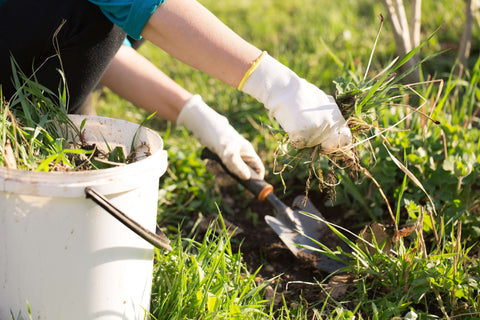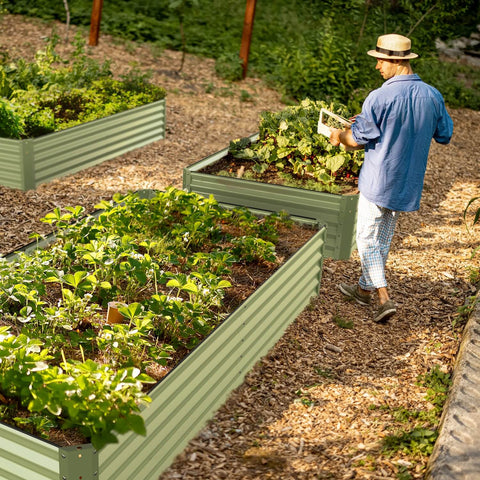Summer is one of the busiest seasons for garden beds, with high temperatures and dry weather challenging plant growth. Proper management is key to keeping garden beds healthy and beautiful. This article introduces some summer garden bed management tips to help you protect plants, promote growth, and enjoy the joy of harvest.The following content also has some reference value for raised garden beds.
One, adequate watering:
Frequent watering: In hot, dry summer weather, plants need more water. Make sure garden beds are kept moist, but avoid over-watering. Check soil moisture frequently and water as needed.
Morning or evening watering: Avoid watering during the hot midday hours, as water droplets may cause burns on the leaves. Choose to water in the morning or late afternoon to give the plants enough time to absorb water and to avoid it evaporating too quickly.
Deep watering: Ensure that water penetrates deeper into the soil and promotes healthy growth of plant roots. Avoid superficial watering, where the roots are concentrated only on the surface and are susceptible to dryness and heat.

- Keep proper shade:
Shade netting or awning: In strong sun, providing proper shade for garden beds is key to protecting plants from excessive exposure. Shade netting or awnings can be used to reduce the intensity of direct sunlight hitting the plants.
Shade between plants: Choose tall plants or trees to provide shade for low plants. This not only reduces sun exposure, but also creates a microclimate that keeps the garden bed moist and warm.
- Regular pruning and weeding:
Remove dead leaves and flowers: Check your garden bed regularly for dead leaves and flowers, and prune and remove them promptly. This helps the plant concentrate on growth and reduces the number of pests and diseases.
Weeding: Summer is the season for rapid growth of weeds. Weed regularly to keep your garden bed clean and reduce competition for water and nutrients from weeds.
Iv. Fertilization and nutrition Supplement
Understand plant needs: Different plants have different nutrient needs. Know the type and amount of nutrients needed for the plants you grow before applying fertilizer. You can get advice by looking at relevant materials or consulting a professional horticulturist.
Use of organic fertilizers: Choose organic fertilizers to supplement your garden bed. Organic fertilizers are good for plant growth and also for the health of the soil. Common organic fertilizers include decomposed compost, animal manure, and plant waste.
Fertilization time and frequency: Summer is the time when plants grow most rapidly, so it is necessary to increase the frequency of fertilization. Apply fertilizer regularly according to the plant's needs and follow the amount recommended on the fertilizer package.
Nutritional supplements: In addition to regular fertilization, consider supplementing plants with specific nutrients. For example, if you find that the plant is deficient in specific trace elements (such as iron, zinc, or magnesium), you can supplement them with the appropriate nutritional supplement.
- Pest Control:

Inspection and monitoring: Make regular visits to the plants in the garden bed and look closely at the leaves, stems and flowers for any signs of pests and diseases. Early detection and timely treatment of pests and diseases can prevent their spread.
Biological control: Encouraging natural enemies such as beneficial insects, birds and bees to control the growth of pests. You can provide garden beds with an environment suitable for their habitat, such as an insect tavern or bird feeder. In addition, some plants themselves have repellent properties, and planting these plants can help reduce pest infestation.
Use organic pesticides: If pests and diseases are a serious problem, consider using organic pesticides to control the growth of pests. Choose organic pesticides that are specific to the target pest and environmentally friendly, and apply them correctly according to the instructions.
Rotating planting for pest control: Regularly changing the type and location of plants in your garden bed can reduce the spread and accumulation of pests and diseases. This practice of rotating planting helps keep garden beds healthy and reduces the risk of pests and diseases.

Cleaning and disposal: Clean and dispose of infected plant parts in a timely manner to prevent the spread of disease. Remove infected leaves, branches or plant residues from the garden bed and dispose of them properly to reduce the reappearance of pests and diseases.
Six, grass sawdust covering layer:
Laying a layer of grass sawdust on a garden bed will moisturize and inhibit weed growth. Grass sawdust reduces water evaporation, helps maintain soil moisture, and reduces competition from weeds for plants.
Summer garden bed management requires a combination of watering, shading, pruning and weeding, fertilization, and pest control. Maintain water supply to plants, provide proper shade, regular pruning and weeding, provide proper nutritional supplements, and effectively control pests and diseases. With scientific management, you will be able to protect plants, promote growth, and enjoy beautiful flowers and bountiful fruits in summer garden beds.









